Prediction Model for the Performance of Different PV Modules Using Artificial Neural Networks
Abstract
:1. Introduction
| Name of Author | Type of Method | Accuracy (%) |
|---|---|---|
| Malik et al. [14] | Online—Variable Resistor | 69 |
| Van Dyk et al. [15] | 78 | |
| Lorenzo et al. [16] | Online—Capacitive load | 80 |
| Kuai et al. [18] | Online—Electronic load | 91.6 |
| Khatib et al. [20] | Online—DC-DC converter | 63 |
| Navabi et al. [23] | Offline—Numerical models | 90.5–99 |
| Ismail et al. [24] | Offline—Evolutionary algorithms | 78–98.6 |
| Dizqah et al. [25] | ||
| Khatib et al. [33] | Offline—Artificial neural networks | 98.5 |
| Zhang et al. [34] | 99 | |
| Mittal et al. [35] | 99 | |
| Jung et al. [38] | Offline—recurrent neural networks | 90 |
2. Experimental Setup and Major Parameters of the PV Module
3. Proposed ANNs Model for Predicting the Performance of the Six PV Modules
4. Result and Discussion
5. Conclusions
Author Contributions
Funding
Data Availability Statement
Acknowledgments
Conflicts of Interest
Abbreviations
| PV | Photovoltaic |
| IV | Current–voltage |
| BIPV | Building-integrated photovoltaic |
| Isc | Short-circuit current |
| Voc | Open-circuit voltage |
| Tc | Cell temperature |
| FF | Fill factor |
| PR | Performance ratio |
| MPPT | Maximum power point |
| Pm | Maximum power |
| Im | Maximum current |
| Vm | Maximum voltage |
| Pin | Input power |
| η | Efficiency |
| ANNs | Artificial neural networks |
| AI | Artificial intelligence |
| GA | Genetic algorithm |
| RNN | Recurrent neural network |
| GRNN | Generalized regression neural network |
| Voc_T | Open-circuit voltage under test conditions |
| Voc_STC | Open-circuit voltage under standard test conditions |
| Ta | Ambient temperature |
| Isc_T | Short-circuit current under test conditions |
| Isc_STC | Short-circuit current under standard test conditions |
| MAPE | Mean absolute percentage error |
| r | Number of the value |
| xi | Predicted value |
| m(X) | Dataset’s average |
| RMSE | Root mean square error |
| MAD | Mean absolute deviation |
| xe | Experimental value |
References
- Sukarno, K.; Hamid, A.S.A.; Jackson, C.H.W.; Pien, C.F.; Dayou, J. Comparison of power output between fixed and perpendicular solar photovoltaic PV panel in tropical climate region. Adv. Sci. Lett. 2017, 23, 1259–1263. [Google Scholar] [CrossRef]
- Parida, B.; Iniyan, S.; Goic, R. A review of solar photovoltaic technologies. Renew. Sustain. Energy Rev. 2011, 15, 1625–1636. [Google Scholar] [CrossRef]
- Baljit, S.S.S.; Chan, H.-Y.; Sopian, K. Review of building integrated applications of photovoltaic and solar thermal systems. J. Clean. Prod. 2016, 137, 677–689. [Google Scholar] [CrossRef]
- Fudholi, A.; Sopian, K.; Yazdi, M.H.; Ruslan, M.H.; Ibrahim, A.; Kazem, H.A. Performance analysis of photovoltaic thermal (PVT) water collectors. Energy Convers. Manag. 2014, 78, 641–651. [Google Scholar] [CrossRef]
- Abdul Hamid, S.; Yusof Othman, M.; Sopian, K.; Zaidi, S.H. An overview of photovoltaic thermal combination (PV/T combi) technology. Renew. Sustain. Energy Rev. 2014, 38, 212–222. [Google Scholar] [CrossRef]
- Abd Hamid, A.S.; Makmud, M.Z.H.; Abd Rahman, A.B.; Jamain, Z.; Ibrahim, A. Investigation of Potential of Solar Photovoltaic System as an Alternative Electric Supply on the Tropical Island of Mantanani Sabah Malaysia. Sustainability 2021, 13, 12432. [Google Scholar] [CrossRef]
- Sukarno, K.; Hamid, A.S.A.; Razali, H.; Dayou, J. Evaluation on cooling effect on solar PV power output using Laminar H2O surface method. Int. J. Renew. Energy Res. 2017, 7, 1213–1218. [Google Scholar]
- Abd Hamid, A.S.; Ibrahim, A.; Mat, S.; Sukarno, K.; Dayou, J. Evaluation on Low Temperature and Tracking Effect of Solar Photovoltaic Power Output Under Tropical Climate Condition in Kota Kinabalu, Malaysia. In Proceedings of the 2nd Malaysia University-Industry Green Building Collaboration Symposium (MU-IGBC 2018), Bangi, Malaysia, 8 May 2018; pp. 227–231. [Google Scholar]
- Darwish, Z.A.; Kazem, H.A.; Sopian, K.; Al-Goul, M.A.; Alawadhi, H. Effect of dust pollutant type on photovoltaic performance. Renew. Sustain. Energy Rev. 2015, 41, 735–744. [Google Scholar] [CrossRef]
- Darwish, Z.A.; Sopian, K.; Fudholi, A. Reduced output of photovoltaic modules due to different types of dust particles. J. Clean. Prod. 2021, 280, 124317. [Google Scholar] [CrossRef]
- Mirzaei, M.; Mohiabadi, M.Z. A comparative analysis of long-term field test of monocrystalline and polycrystalline PV power generation in semi-arid climate conditions. Energy Sustain. Dev. 2017, 38, 93–101. [Google Scholar] [CrossRef]
- Silvestre, S.; Tahri, A.; Tahri, F.; Benlebna, S.; Chouder, A. Evaluation of the performance and degradation of crystalline silicon-based photovoltaic modules in the Saharan environment. Energy 2018, 152, 57–63. [Google Scholar] [CrossRef]
- Ram, J.P.; Manghani, H.; Pillai, D.S.; Babu, T.S.; Miyatake, M.; Rajasekar, N. Analysis on solar PV emulators: A review. Renew. Sustain. Energy Rev. 2018, 81, 149–160. [Google Scholar] [CrossRef]
- Malik, A.Q.; Damit, S.J.B.H. Outdoor testing of single crystal silicon solar cells. Renew. Energy 2003, 28, 1433–1445. [Google Scholar] [CrossRef]
- Van Dyk, E.E.; Gxasheka, A.R.; Meyer, E.L. Monitoring current–voltage characteristics and energy output of silicon photovoltaic modules. Renew. Energy 2005, 30, 399–411. [Google Scholar] [CrossRef]
- Muñoz, J.; Lorenzo, E. Capacitive load based on IGBTs for on-site characterization of PV arrays. Sol. Energy 2006, 80, 1489–1497. [Google Scholar] [CrossRef] [Green Version]
- Forero, N.; Hernández, J.; Gordillo, G. Development of a monitoring system for a PV solar plant. Energy Convers. Manag. 2006, 47, 2329–2336. [Google Scholar] [CrossRef]
- Kuai, Y.; Yuvarajan, S. An electronic load for testing photovoltaic panels. J. Power Sources 2006, 154, 308–313. [Google Scholar] [CrossRef]
- Duran, E.; Galan, J.; Sidrach-de-Cardona, M.; Andujar, J.M. A New Application of the Buck-Boost-Derived Converters to Obtain the I-V Curve of Photovoltaic Modules. In Proceedings of the 2007 IEEE Power Electronics Specialists Conference, Orlando, FL, USA, 17–21 June 2007; pp. 413–417. [Google Scholar]
- Khatib, T.; Elmenreich, W.; Mohamed, A. Simplified I–V Characteristic Tester for Photovoltaic Modules Using a DC-DC Boost Converter. Sustainability 2017, 9, 657. [Google Scholar] [CrossRef] [Green Version]
- Bai, J.; Liu, S.; Hao, Y.; Zhang, Z.; Jiang, M.; Zhang, Y. Development of a new compound method to extract the five parameters of PV modules. Energy Convers. Manag. 2014, 79, 294–303. [Google Scholar] [CrossRef]
- Ma, T.; Yang, H.; Lu, L. Development of a model to simulate the performance characteristics of crystalline silicon photovoltaic modules/strings/arrays. Sol. Energy 2014, 100, 31–41. [Google Scholar] [CrossRef]
- Navabi, R.N.; Abedi, S.; Hosseinian, S.H.; Pal, R. On the fast convergence modeling and accurate calculation of PV output energy for operation and planning studies. Energy Convers. Manag. 2015, 89, 497–506. [Google Scholar] [CrossRef]
- Ismail, M.S.; Moghavvemi, M.; Mahlia, T.M.I. Characterization of PV panel and global optimization of its model parameters using genetic algorithm. Energy Convers. Manag. 2013, 73, 10–25. [Google Scholar] [CrossRef]
- Dizqah, A.M.; Maheri, A.; Busawon, K. An accurate method for the PV model identification based on a genetic algorithm and the interior-point method. Renew. Energy 2014, 72, 212–222. [Google Scholar] [CrossRef] [Green Version]
- Jiang, L.L.; Maskell, D.L.; Patra, J.C. Parameter estimation of solar cells and modules using an improved adaptive differential evolution algorithm. Appl. Energy 2013, 112, 185–193. [Google Scholar] [CrossRef]
- Muhsen, D.H.; Ghazali, A.B.; Khatib, T.; Abed, I.A. A comparative study of evolutionary algorithms and adapting control parameters for estimating the parameters of a single-diode photovoltaic module’s model. Renew. Energy 2016, 96, 377–389. [Google Scholar] [CrossRef]
- Sukarno, K.; Abd Hamid, A.S.; Dayou, J.; Makmud, M.Z.H.; Sarjadi, M.S. Measurement of global solar radiation in Kota Kinabalu Malaysia. ARPN J. Eng. Appl. Sci. 2015, 10, 6467–6471. [Google Scholar]
- Hamid, A.S.A.; Ibrahim, A.; Assadeg, J.; Ahmad, E.Z.; Sopian, K. Techno-economic Analysis of a Hybrid Solar Dryer with a Vacuum Tube Collector for Hibiscus Cannabinus L Fiber. Int. J. Renew. Energy Res. 2020, 10, 1609–1613. [Google Scholar]
- Khatib, T.; Mohamed, A.; Sopian, K.; Mahmoud, M. Assessment of Artificial Neural Networks for Hourly Solar Radiation Prediction. Int. J. Photoenergy 2012, 2012, 946890. [Google Scholar] [CrossRef]
- El-kenawy, E.M.T. Solar Radiation Machine Learning Production Depend on Training Neural Networks with Ant Colony Optimization Algorithms. Int. J. Adv. Res. Comput. Commun. Eng. 2018, 7, 1–4. [Google Scholar]
- Sivaneasan, B.; Yu, C.Y.; Goh, K.P. Solar Forecasting using ANN with Fuzzy Logic Pre-processing. Energy Procedia 2017, 143, 727–732. [Google Scholar] [CrossRef]
- Khatib, T.; Ghareeb, A.; Tamimi, M.; Jaber, M.; Jaradat, S. A new offline method for extracting I-V characteristic curve for photovoltaic modules using artificial neural networks. Sol. Energy 2018, 173, 462–469. [Google Scholar] [CrossRef]
- Zhang, C.; Zhang, Y.; Su, J.; Gu, T.; Yang, M. Performance prediction of PV modules based on artificial neural network and explicit analytical model Performance prediction of PV modules based on artificial neural network and explicit analytical model. J. Renew. Sustain. Energy 2020, 12, 013501. [Google Scholar] [CrossRef]
- Mittal, M.; Bora, B.; Saxena, S.; Mli, A. Performance prediction of PV module using electrical equivalent model and artificial neural network. Sol. Energy 2018, 176, 104–117. [Google Scholar] [CrossRef]
- Ibrahim, I.A.; Hossain, M.J.; Member, S.; Duck, B.C. An Optimized Offline Random Forests-Based Model for Ultra-short-term Prediction of PV Characteristics. IEEE Trans. Ind. Inform. 2019, 16, 202–214. [Google Scholar] [CrossRef]
- Theocharides, S.; Makrides, G.; George, E.; Kyprianou, A. System Power Output Prediction. In Proceedings of the 2018 IEEE International Energy Conference (ENERGYCON), Limassol, Cyprus, 3–7 June 2018; pp. 1–6. [Google Scholar]
- Jung, Y.; Jung, J.; Kim, B.; Han, S. Long short-term memory recurrent neural network for modeling temporal patterns in long-term power forecasting for solar PV facilities: Case study of South Korea. J. Clean. Prod. 2020, 250, 119476. [Google Scholar] [CrossRef]
- Khandakar, A.; Chowdhury, M.E.H.; Kazi, M.-K.; Benhmed, K.; Touati, F.; Al-hitmi, M.; Gonzales, A.J.S.P. Machine Learning Based Photovoltaics (PV) Power Prediction Using Different Environmental Parameters of Qatar. Energies 2019, 12, 2782. [Google Scholar] [CrossRef] [Green Version]
- Castaner, L.; Silvestre, S. Modelling Photovoltaic Systems Using PSpice; John Wiley and Sons: Hoboken, NJ, USA, 2003; ISBN 9780470855539. [Google Scholar]
- Mosaad, M.I.; abed el-Raouf, M.O.; Al-Ahmar, M.A.; Banakher, F.A. Maximum Power Point Tracking of PV system Based Cuckoo Search Algorithm; review and comparison. Energy Procedia 2019, 162, 117–126. [Google Scholar] [CrossRef]
- Dagli, C.H.; Buczak, A.L.; Ghosh, J.; Embrechts, M.J.; Ersoy, O.; Kercel, S. Intelligent Engineering Systems through Artificial Neural Networks: Volume 10, Fuzzy Logic and Evolutionary Programming; American Society of Mechanical Engineers ASME: New York, NY, USA, 2000; ISBN 0791801616. [Google Scholar]
- Butler, C.; Caudill, M. Understanding Neural Networks—IBM Version, Volume 1: Basic Networks; The MIT Press: Cambridge, MA, USA, 1993; ISBN 9780262530996. [Google Scholar]

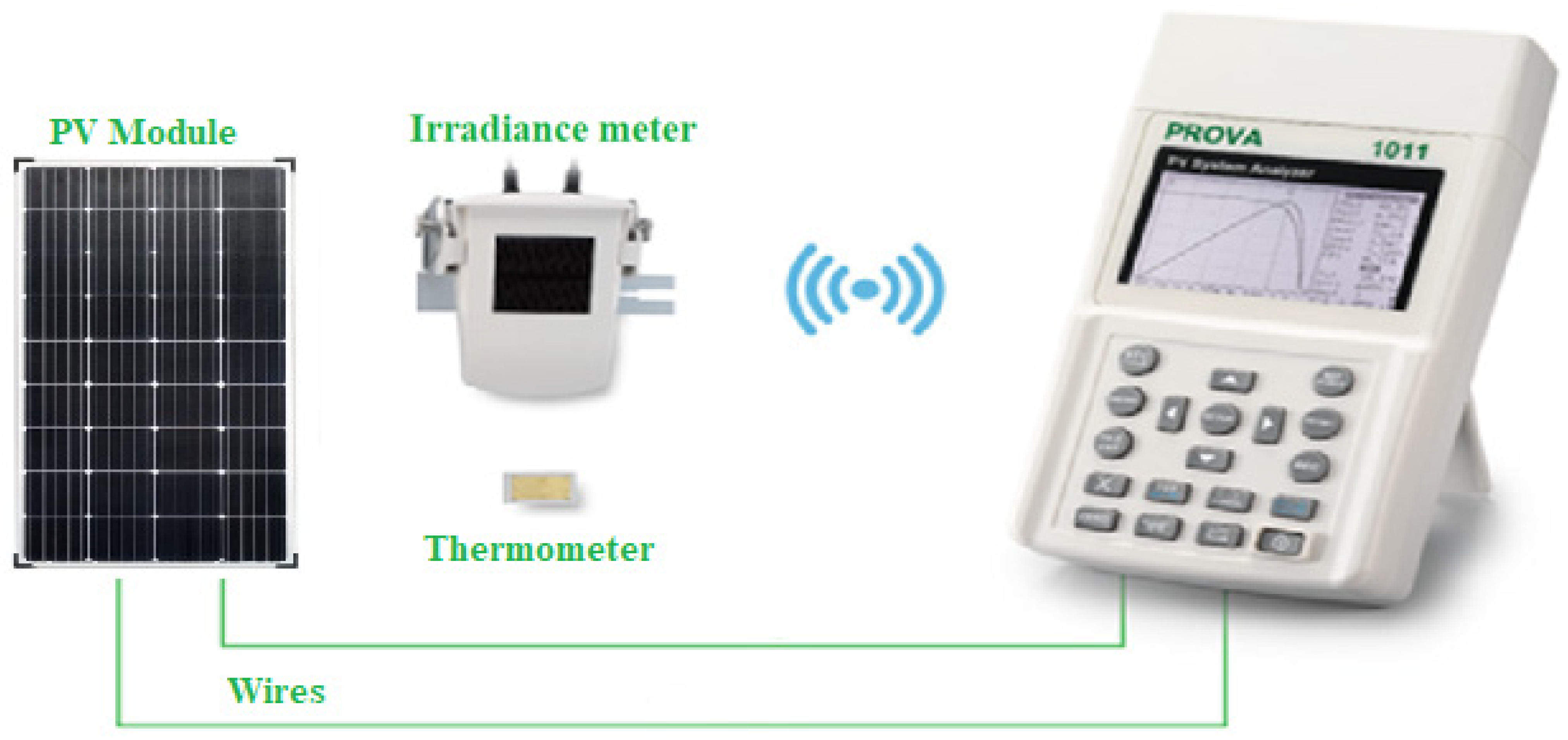
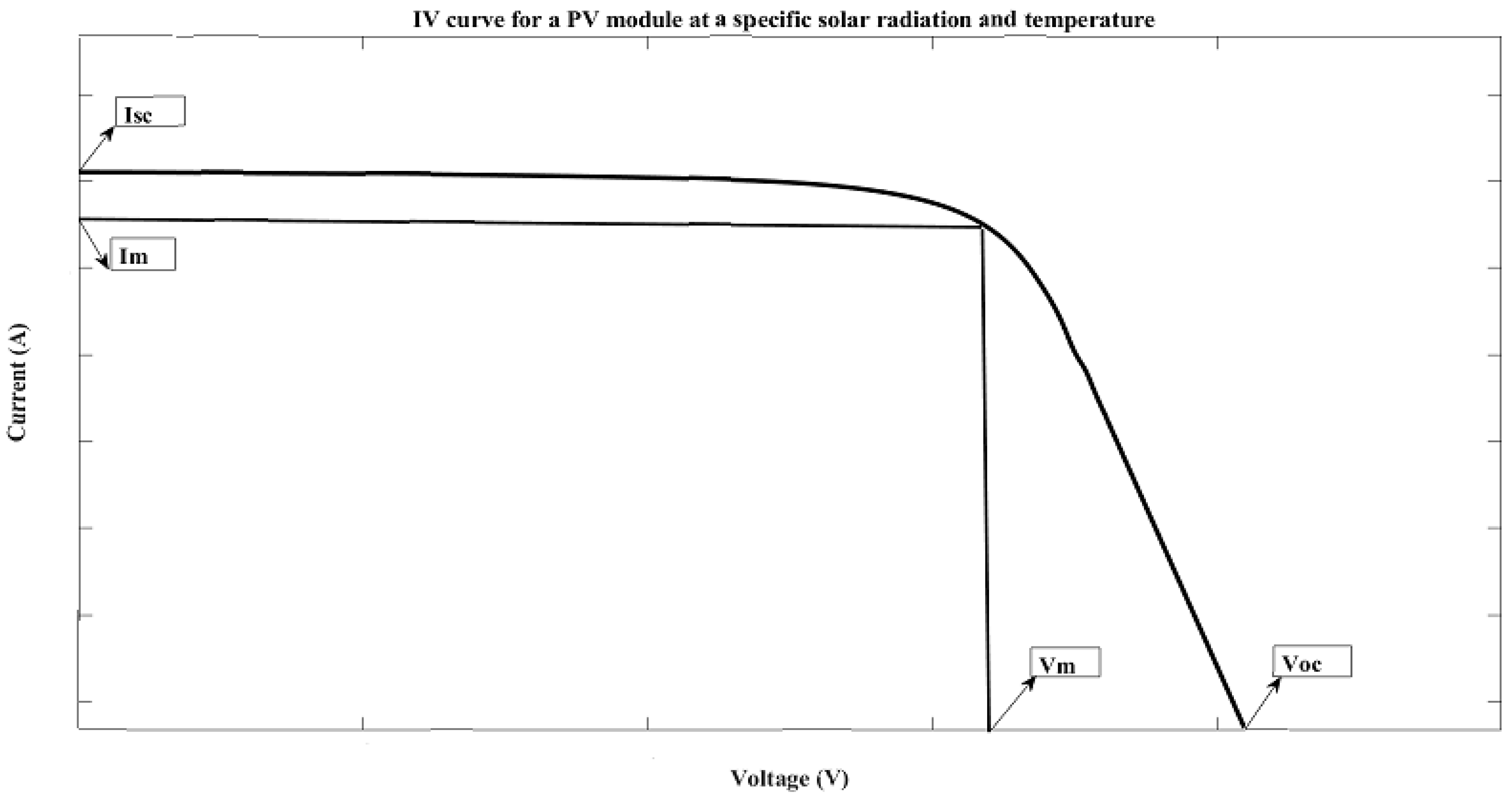
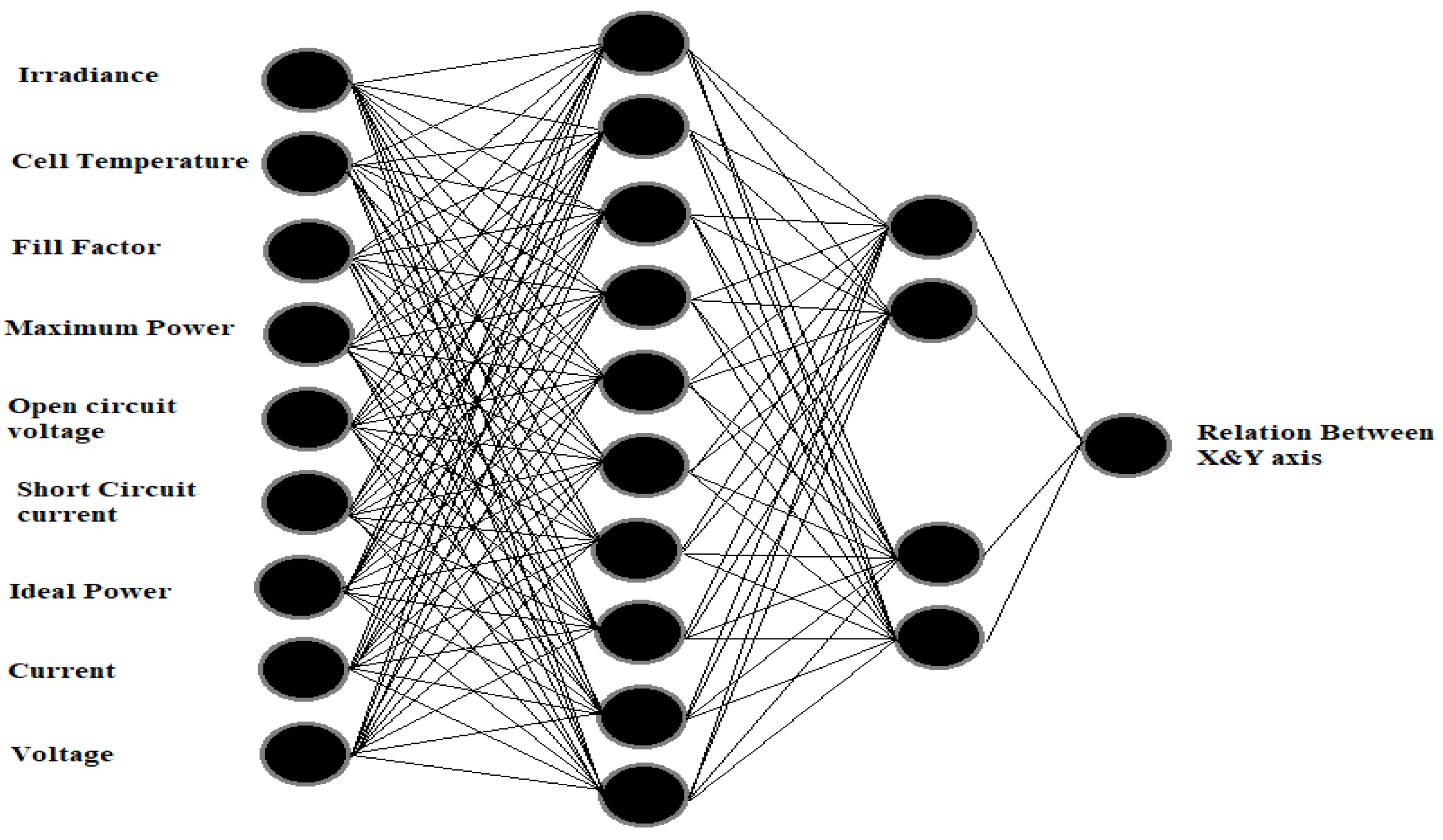
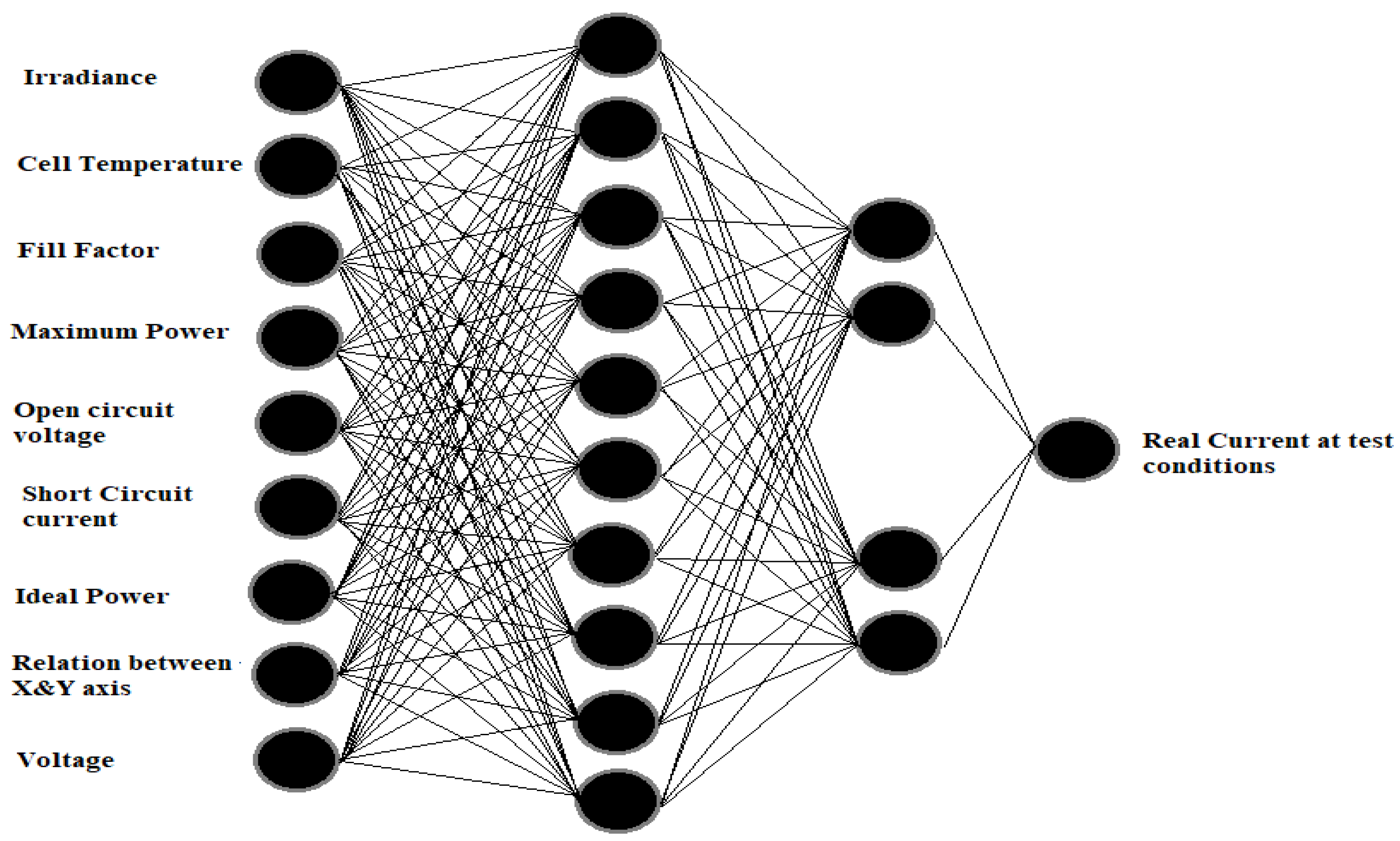
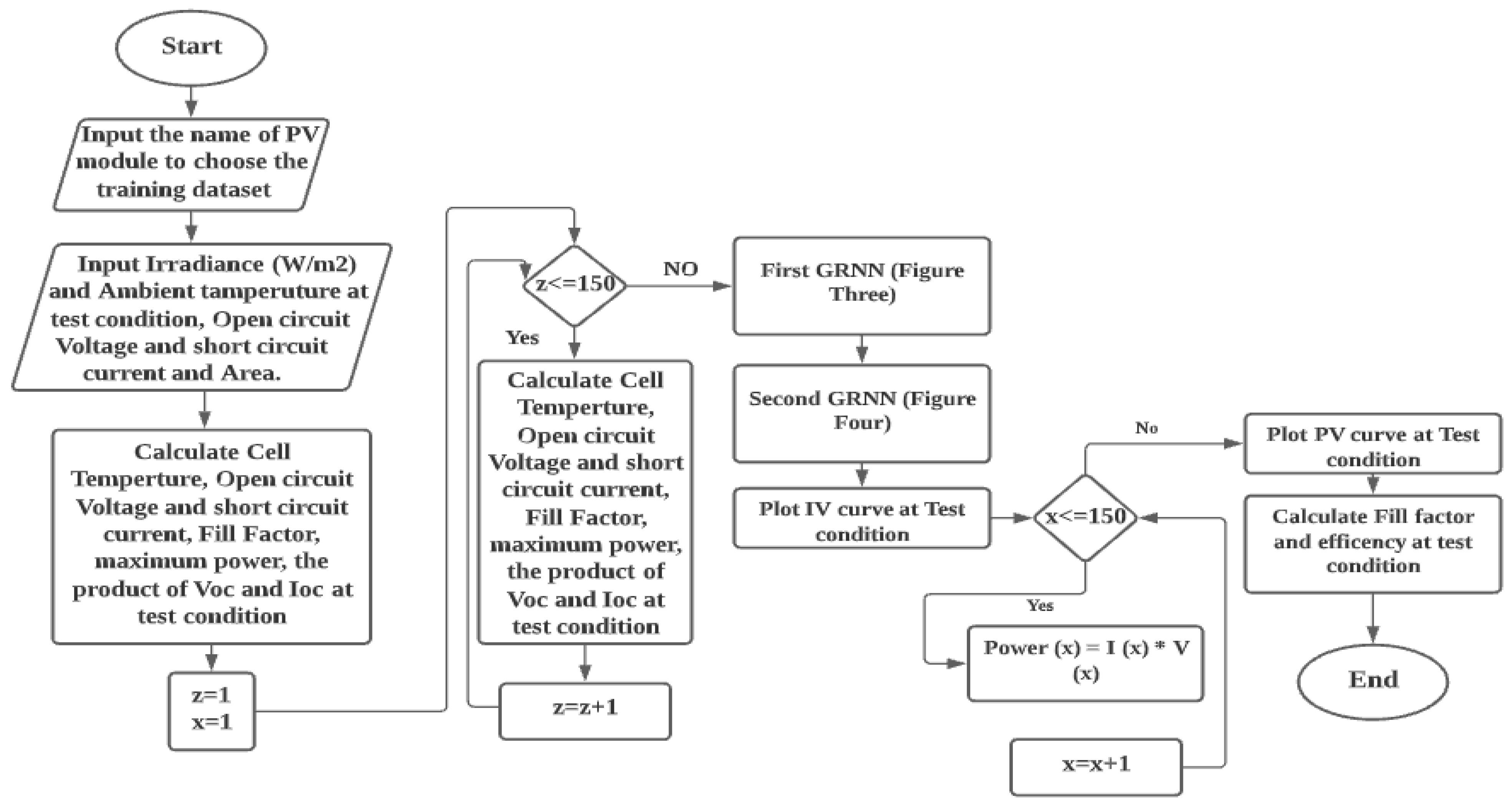
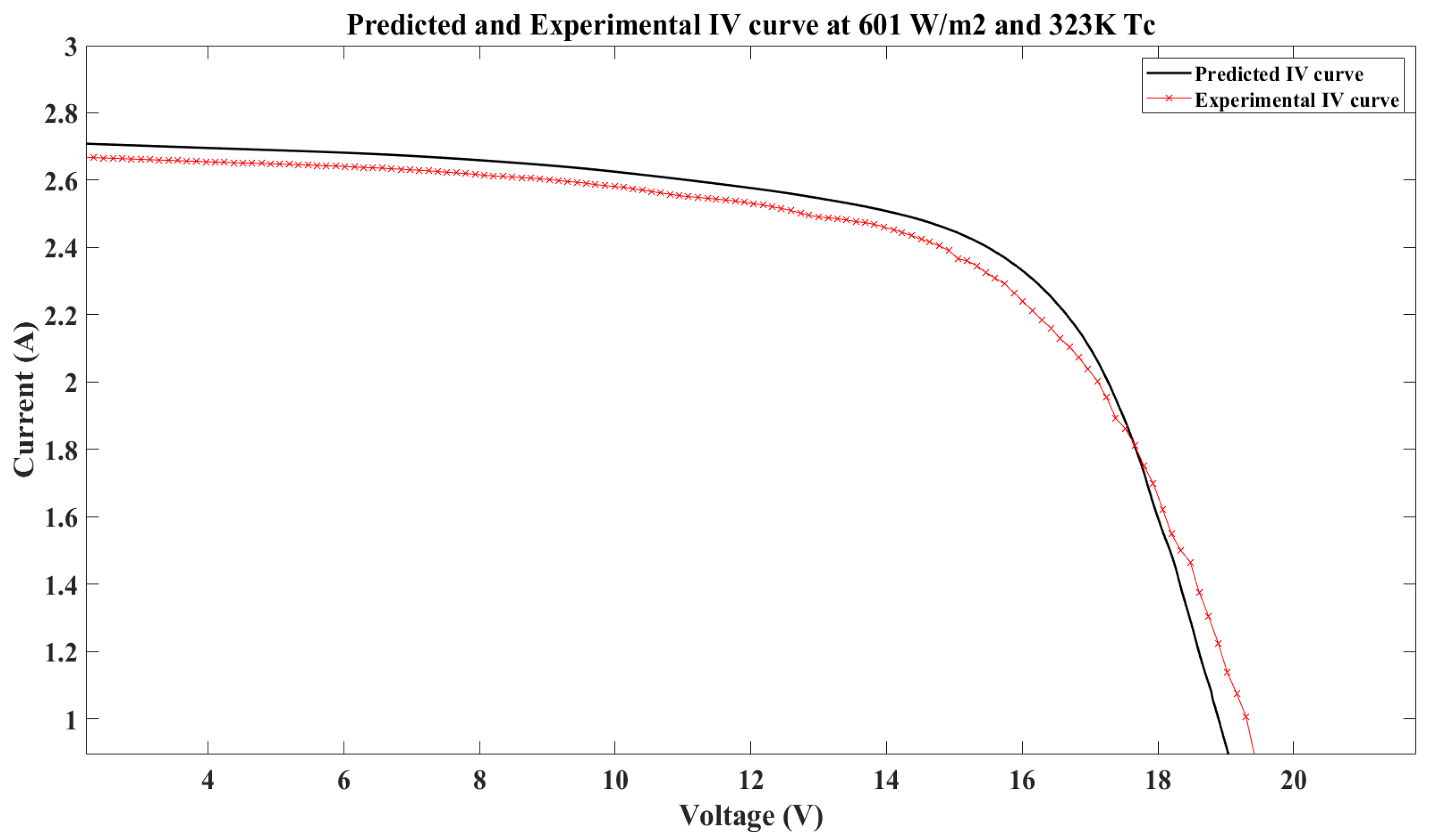


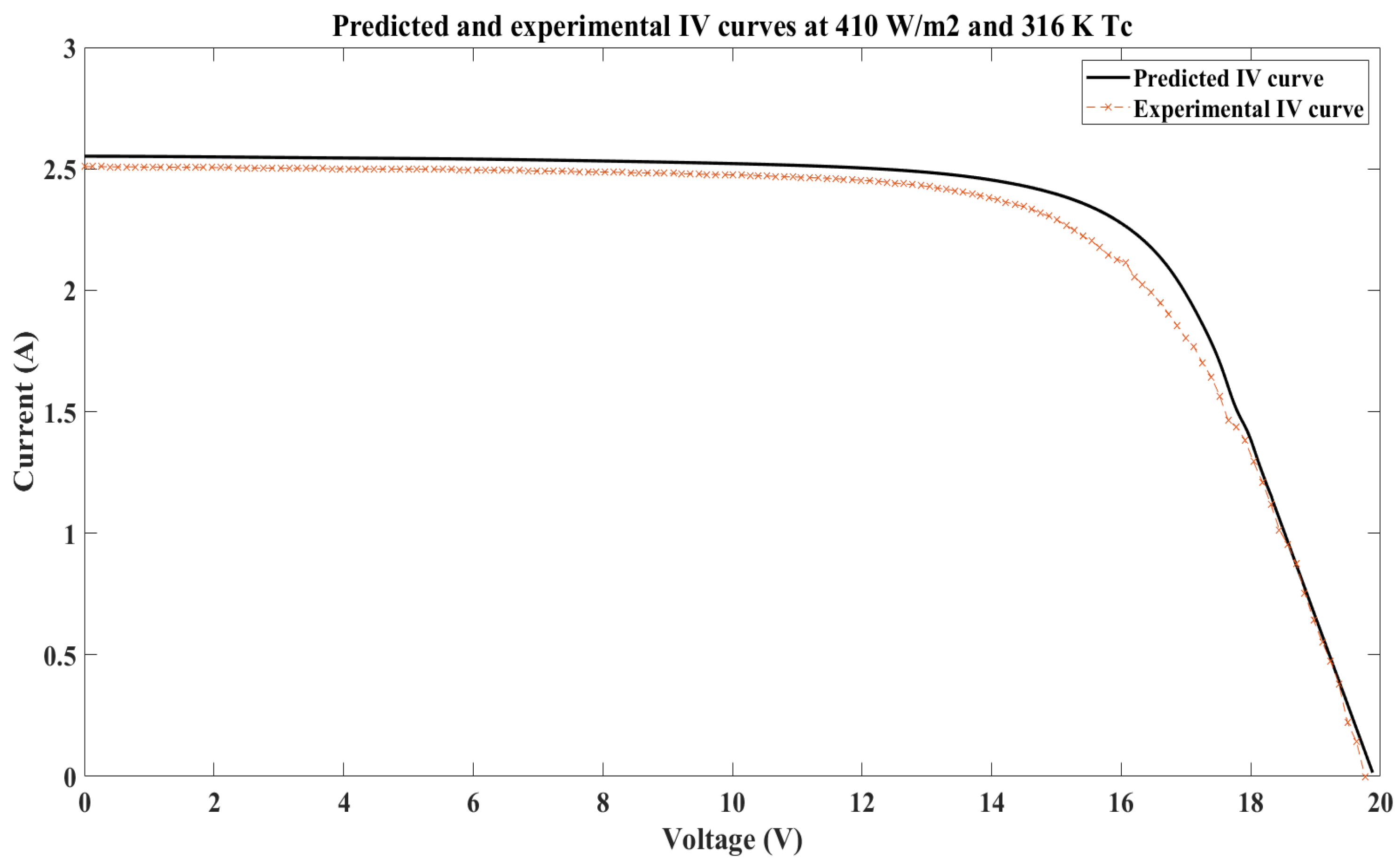
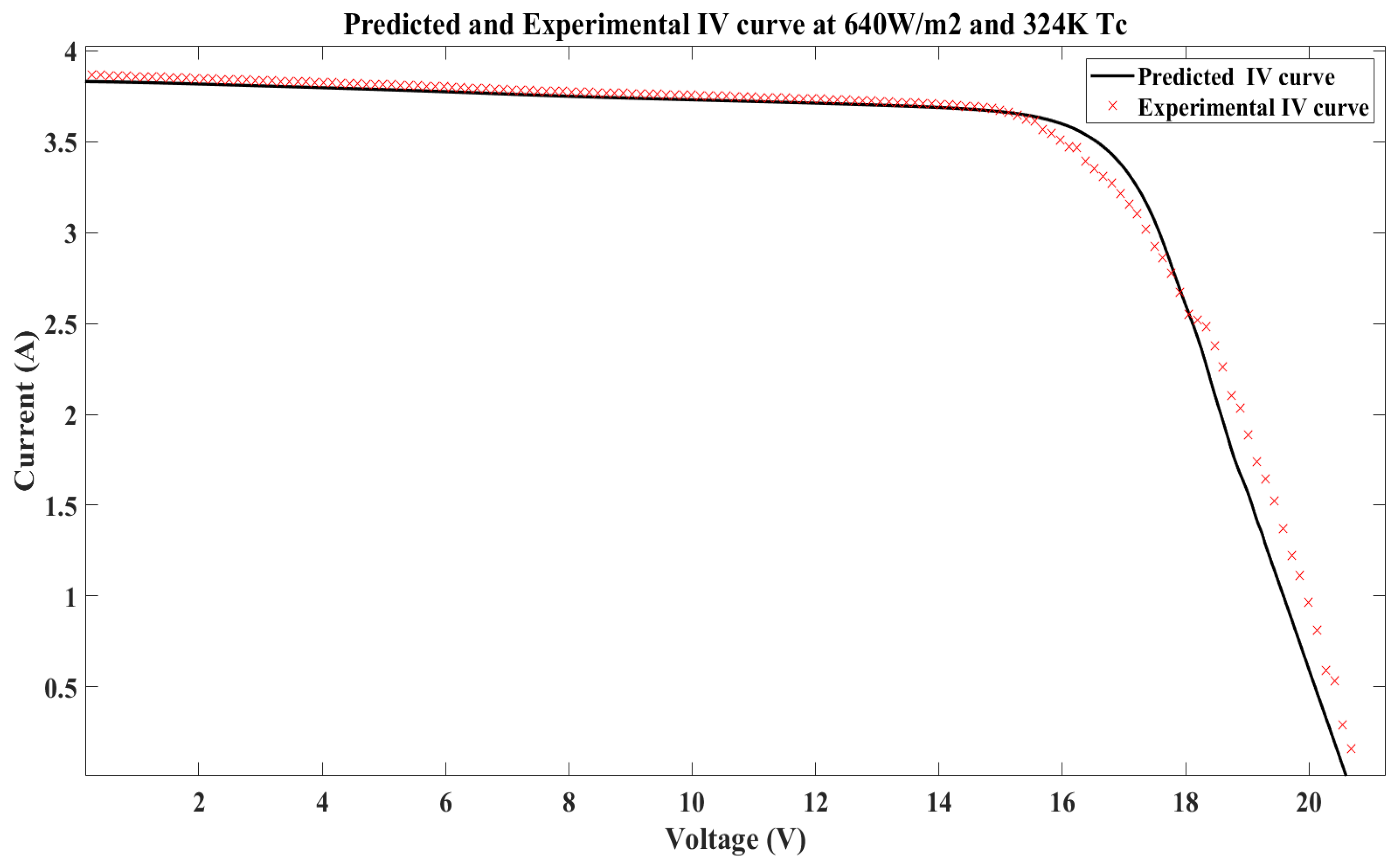
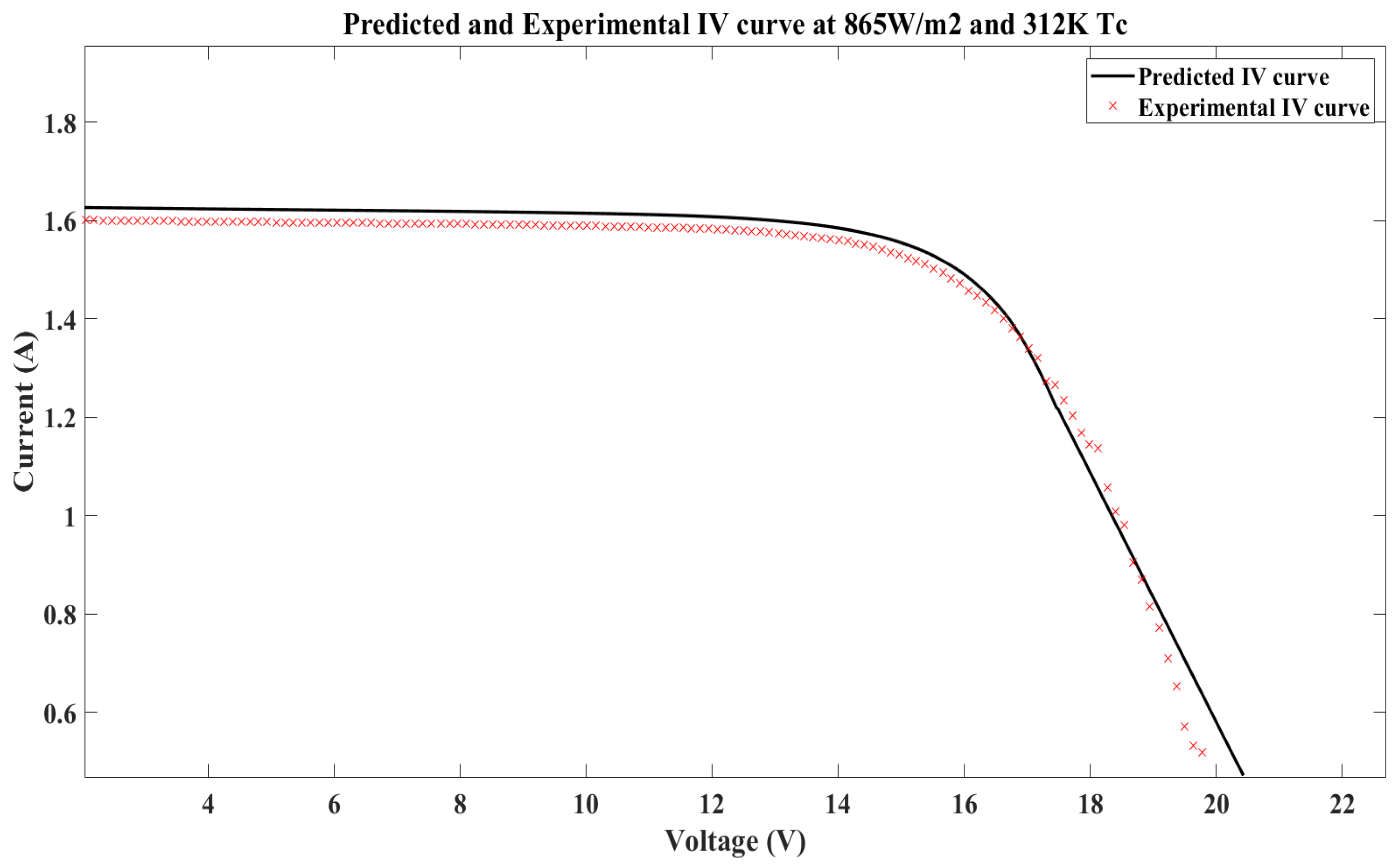
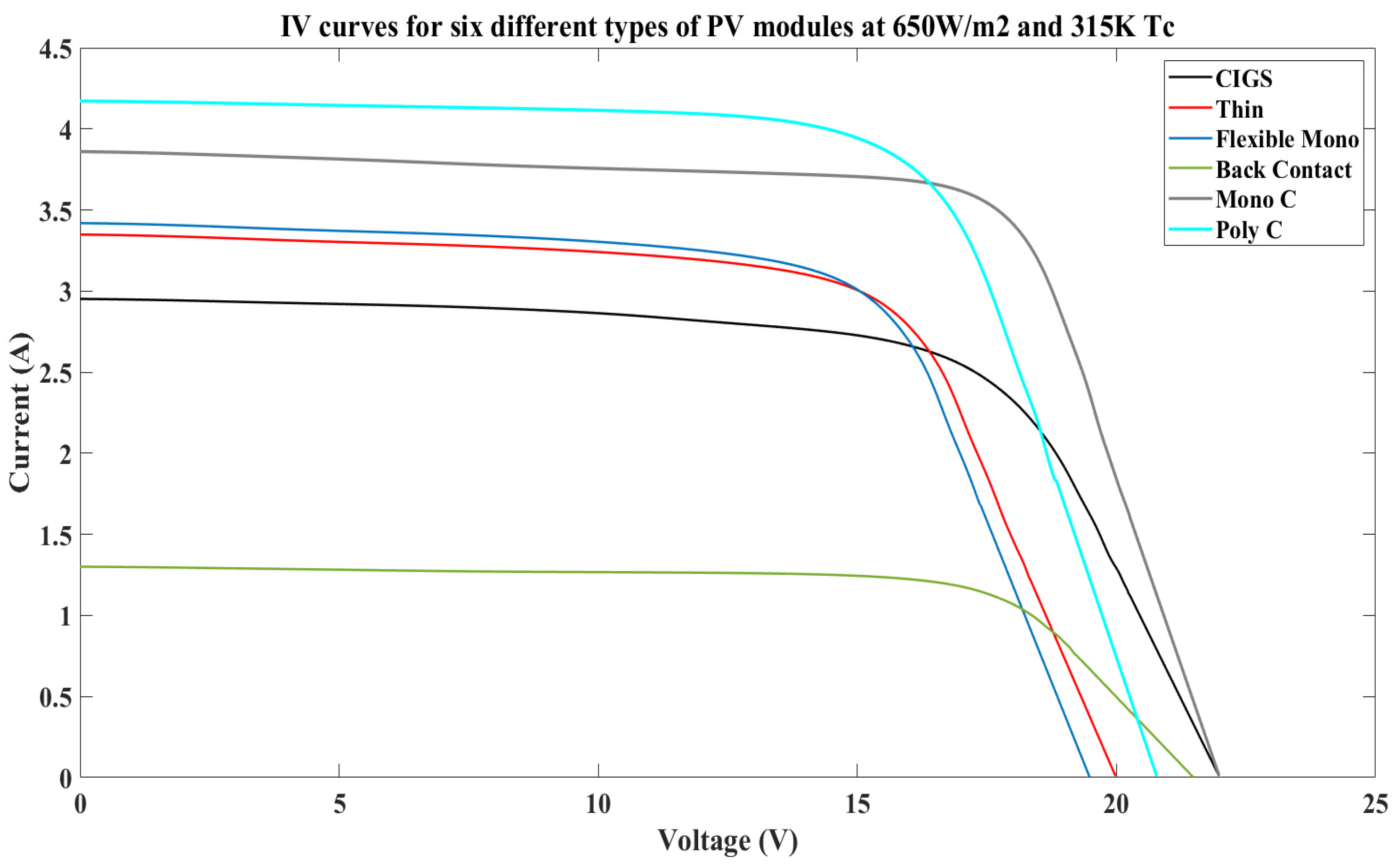
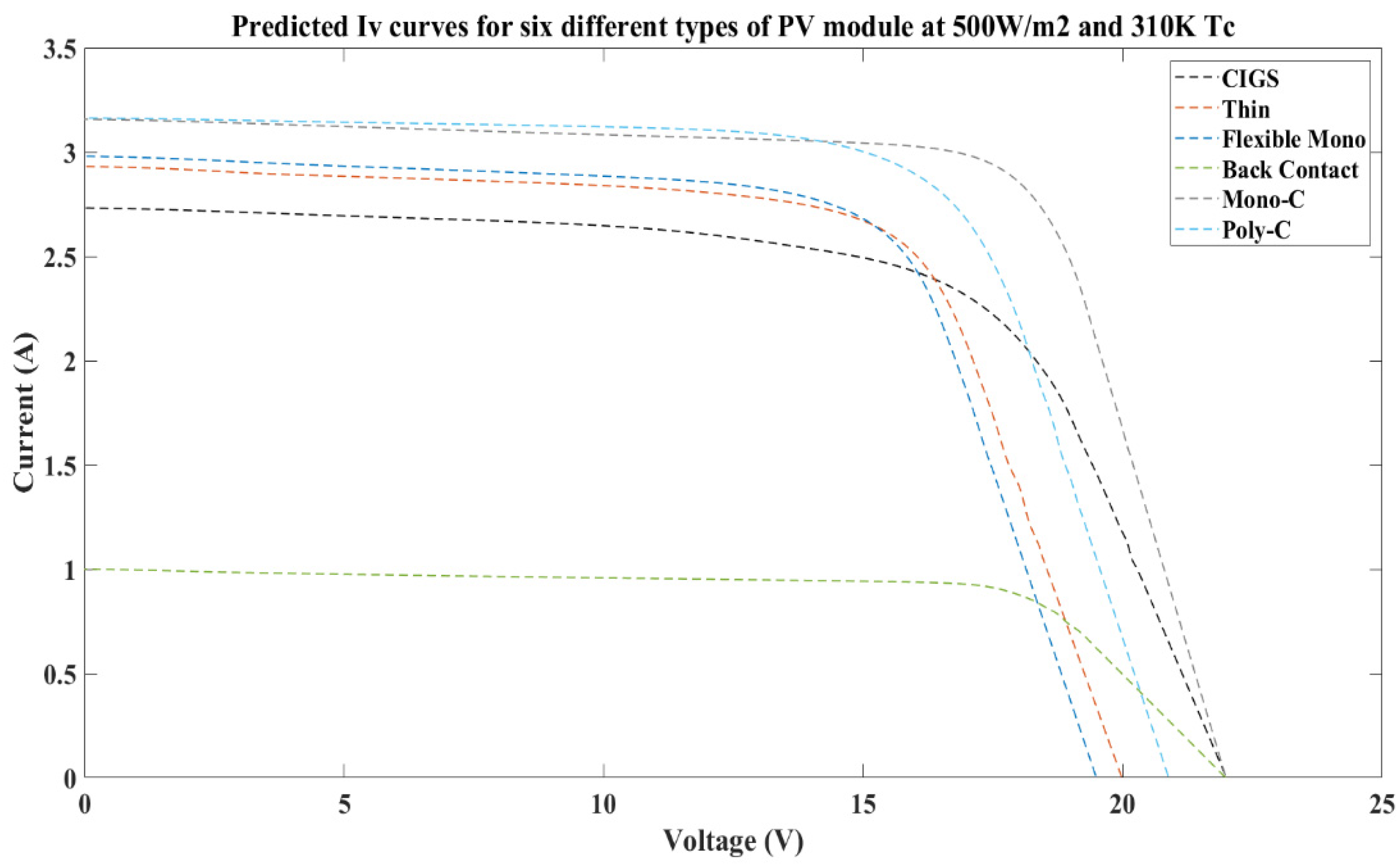
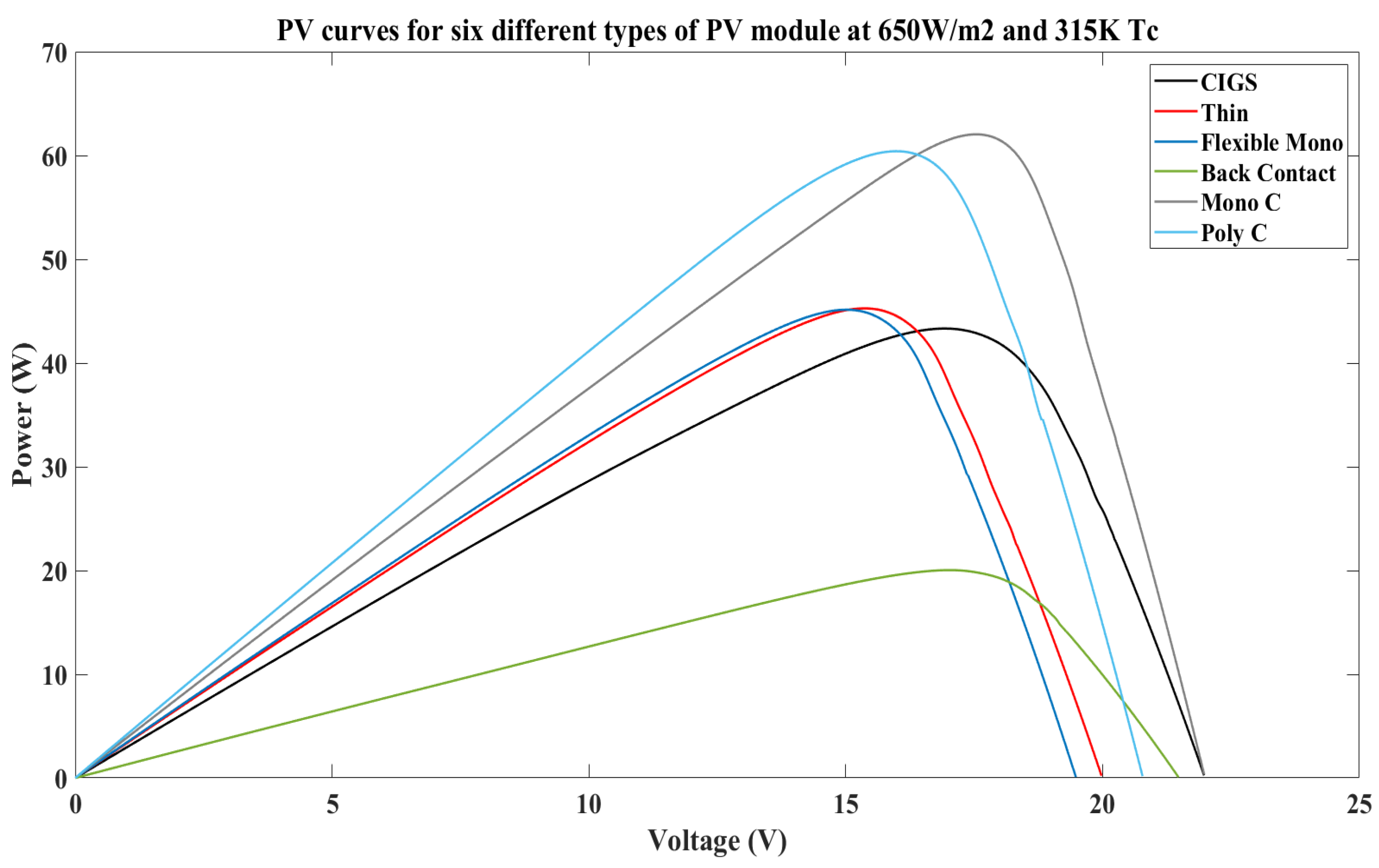
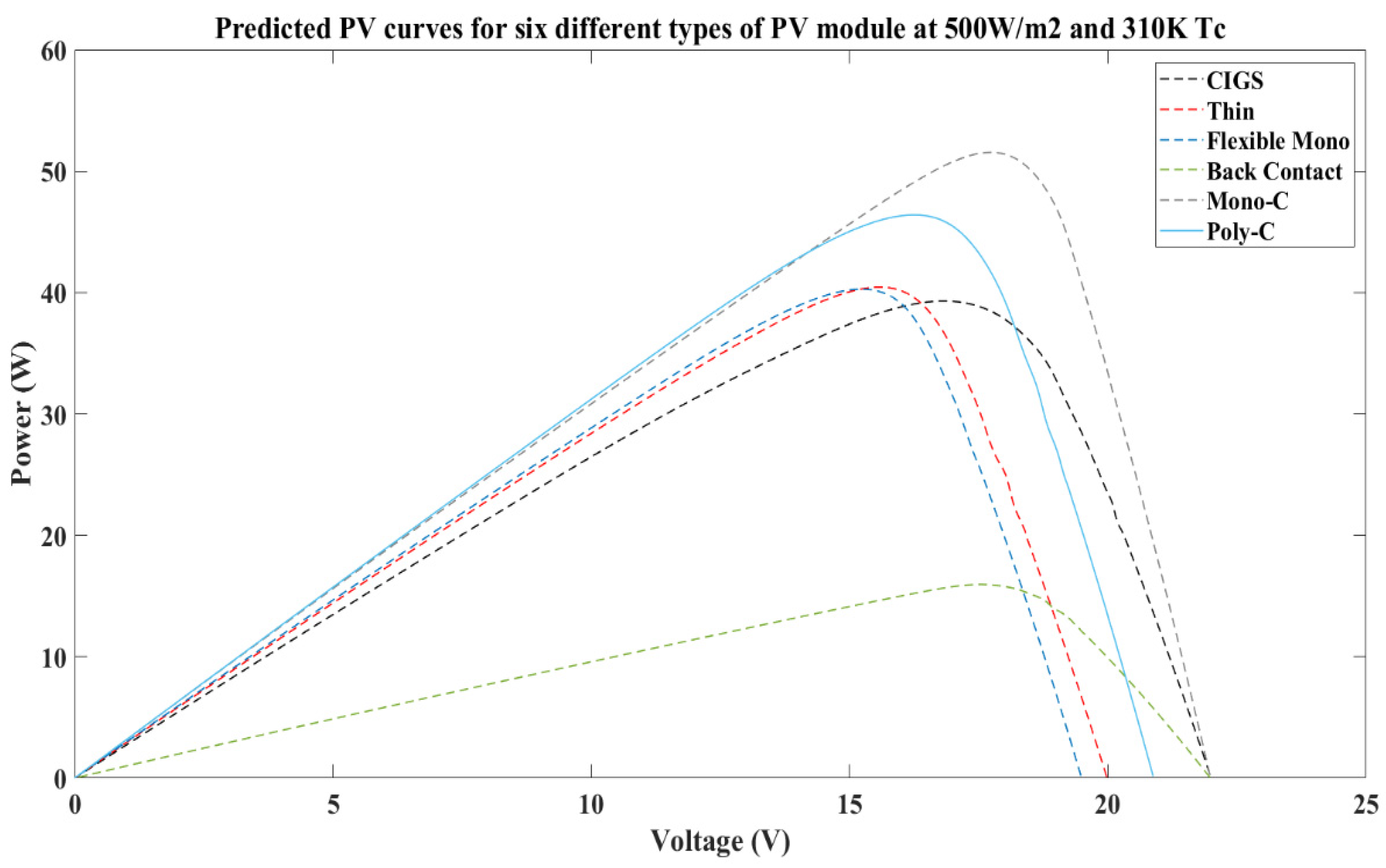
| Types of PV Module | Pm | Voc | Isc | Vm | Im |
|---|---|---|---|---|---|
| CIGS | 90 W | 26.4 V | 5.1 A | 21 V | 4.5 A |
| Thin film | 100 W | 20 V | 5.6 A | 18 V | 5.1 A |
| Flexible mono | 100 W | 19.2 V | 5.68 A | 16 V | 5.15 A |
| Polycrystalline | 100 W | 21.42 V | 5.76 A | 18.59 V | 5.38 A |
| Monocrystalline | 100 W | 21.97 V | 6.07 A | 17.46 V | 5.73 A |
| Flexible back-contact Mono | 30 W | 21.97 V | 1.75 A | 18.31 V | 1.64 A |
| Type of PV Module | Cell Temperature (K) | Irradiance (W/m2) | FF | Efficiency (%) |
|---|---|---|---|---|
| CIGS | 315 | 650 | 0.667845 | 9.6274 |
| 310 | 500 | 0.65454 | 8.7328 | |
| Thin film | 315 | 650 | 0.676499 | 8.083 |
| 310 | 500 | 0.685678 | 7.223 | |
| Flexible mono | 315 | 650 | 0.677629 | 8.0899 |
| 310 | 500 | 0.698835 | 7.323 | |
| Polycrystalline | 315 | 650 | 0.696921 | 10.9832 |
| 310 | 500 | 0.702558 | 8.4353 | |
| Monocrystalline | 315 | 650 | 0.73124 | 11.2789 |
| 310 | 500 | 0.742875 | 9.3722 | |
| Flexible back-contact mono | 315 | 650 | 0.71744 | 8.828 |
| 310 | 500 | 0.725462 | 7.2522 |
| Type of PV Module | Irradiance (W/m2) | Tc (K) | MAD | MAPE (%) | RMSE |
|---|---|---|---|---|---|
| Flexible back-contact mono | 547 | 312 | 0.112 | 0.532 | 0.026 |
| CIGS | 716 | 321 | 0.263 | 0.517 | 0.080 |
| Polycrystalline | 550 | 310 | 0.393 | 1.173 | 0.092 |
| Flexible back-contact mono | 695 | 308 | 0.154 | 0.347 | 0.034 |
| Thin film | 401 | 310 | 0.198 | 0.872 | 0.052 |
| Flexible mono | 395 | 314 | 0.232 | 0.985 | 0.064 |
| Flexible back-contact mono | 865 | 315 | 0.196 | 1.069 | 0.035 |
| Monocrystalline | 750 | 327 | 0.34 | 1.186 | 0.098 |
| CIGS | 840 | 315 | 0.237 | 0.953 | 0.075 |
| Polycrystalline | 473 | 311 | 0.248 | 1.065 | 0.082 |
| Thin film | 570 | 313 | 0.174 | 0.775 | 0.041 |
| Monocrystalline | 380 | 308 | 0.291 | 1.024 | 0.087 |
Publisher’s Note: MDPI stays neutral with regard to jurisdictional claims in published maps and institutional affiliations. |
© 2022 by the authors. Licensee MDPI, Basel, Switzerland. This article is an open access article distributed under the terms and conditions of the Creative Commons Attribution (CC BY) license (https://creativecommons.org/licenses/by/4.0/).
Share and Cite
Jaber, M.; Abd Hamid, A.S.; Sopian, K.; Fazlizan, A.; Ibrahim, A. Prediction Model for the Performance of Different PV Modules Using Artificial Neural Networks. Appl. Sci. 2022, 12, 3349. https://doi.org/10.3390/app12073349
Jaber M, Abd Hamid AS, Sopian K, Fazlizan A, Ibrahim A. Prediction Model for the Performance of Different PV Modules Using Artificial Neural Networks. Applied Sciences. 2022; 12(7):3349. https://doi.org/10.3390/app12073349
Chicago/Turabian StyleJaber, Mahmoud, Ag Sufiyan Abd Hamid, Kamaruzzaman Sopian, Ahmad Fazlizan, and Adnan Ibrahim. 2022. "Prediction Model for the Performance of Different PV Modules Using Artificial Neural Networks" Applied Sciences 12, no. 7: 3349. https://doi.org/10.3390/app12073349
APA StyleJaber, M., Abd Hamid, A. S., Sopian, K., Fazlizan, A., & Ibrahim, A. (2022). Prediction Model for the Performance of Different PV Modules Using Artificial Neural Networks. Applied Sciences, 12(7), 3349. https://doi.org/10.3390/app12073349








